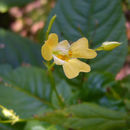Associations
provided by BioImages, the virtual fieldguide, UK
Foodplant / pathogen
amphigenous colony of Mycocentrospora anamorph of Mycocentrospora acerina infects and damages live leaf of Impatiens parviflora
In Great Britain and/or Ireland:
Foodplant / feeds on
epiphyllous, usually infertile pycnidium of Phyllosticta coelomycetous anamorph of Phyllosticta impatientis feeds on live leaf of Impatiens parviflora
Remarks: season: 8-9
Plant / resting place / on
puparium of Phytoliriomyza melampyga may be found on leaf of Impatiens parviflora
Description
provided by eFloras
Plants annual, 30-60 cm tall, glabrous or sparsely glandular hairy, with few supporting and fibrous roots. Stem erect, succulent, nodes swollen; branches spreading. Leaves alternate; petiole 1.5-2 cm; leaf blade pale green abaxially, dark green adaxially, elliptic or ovate, 6-11 × 3.5-4.5 cm, membranous, usually with 3 or 4 pairs of stipitate basal glands, lateral veins 5-7 pairs, curved, base cuneate, decurrent to petiole, margin acutely serrate, teeth mucronulate, basally nearly entire, apex acuminate or shortly acute. Inflorescences in upper leaf axils, 4-12-flowered; peduncles ca. as long as or slightly longer than subtending leaf. Pedicels 1-1.5 cm, elongate at fruiting, slender, bracteate at base; bracts persistent, ovate-lanceolate, 2-3 × 1-1.5 mm. Flowers pale yellow, throat often reddish spotted, small, ca. 1 cm deep. Lateral sepals 2, ovate, ca. 3 × 1-1.5 mm, margin entire. Lower sepal navicular, abruptly narrowed into an erect spur; spur conical, 5-7 mm; mouth vertical, ca. 8 mm, tip acute. Upper petal orbicular, ca. 5 mm, apex emarginate, abaxial midvein not thickened; lateral united petals ± clawed, reddish spotted, 1-1.2 cm, 2-lobed; basal lobes reddish spotted, ovate, apex obtuse; distal lobes subdolabriform, 2-lobed. Filaments linear, swollen apically; anthers obtuse. Ovary fusiform, 2-3 mm. Capsule linear-oblong or cylindric, 2-2.5 cm. Seeds few, oblong-ovoid, ca. 3 mm. Fl. Jun-Aug. 2n = 26.
- license
- cc-by-nc-sa-3.0
- copyright
- Missouri Botanical Garden, 4344 Shaw Boulevard, St. Louis, MO, 63110 USA
Distribution
provided by eFloras
Xinjiang [Kazakhstan, Kyrgyzstan, Mongolia, Russia; Europe].
- license
- cc-by-nc-sa-3.0
- copyright
- Missouri Botanical Garden, 4344 Shaw Boulevard, St. Louis, MO, 63110 USA
Habitat
provided by eFloras
Riverbanks, mossy or moist places along canals; 1200-1700 m.
- license
- cc-by-nc-sa-3.0
- copyright
- Missouri Botanical Garden, 4344 Shaw Boulevard, St. Louis, MO, 63110 USA
Impatiens parviflora: Brief Summary
provided by wikipedia EN

Flower
Impatiens parviflora (small balsam, or small-flowered touch-me-not) is a species of annual herbaceous plants in the family Balsaminaceae, native to some areas of Eurasia, naturalized elsewhere and found in damp shady places. Impatiens parviflora can grow in sandy, loamy, and clay soils and prefer moist soil.
- license
- cc-by-sa-3.0
- copyright
- Wikipedia authors and editors


 Flower
Flower